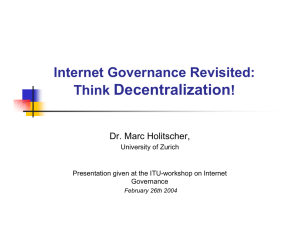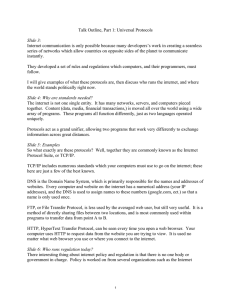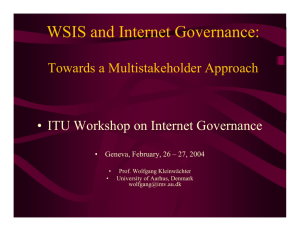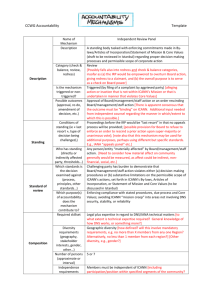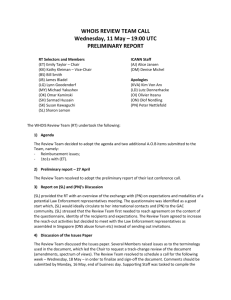Internet Governance Revisited: Think Decentralization! February 2004
advertisement
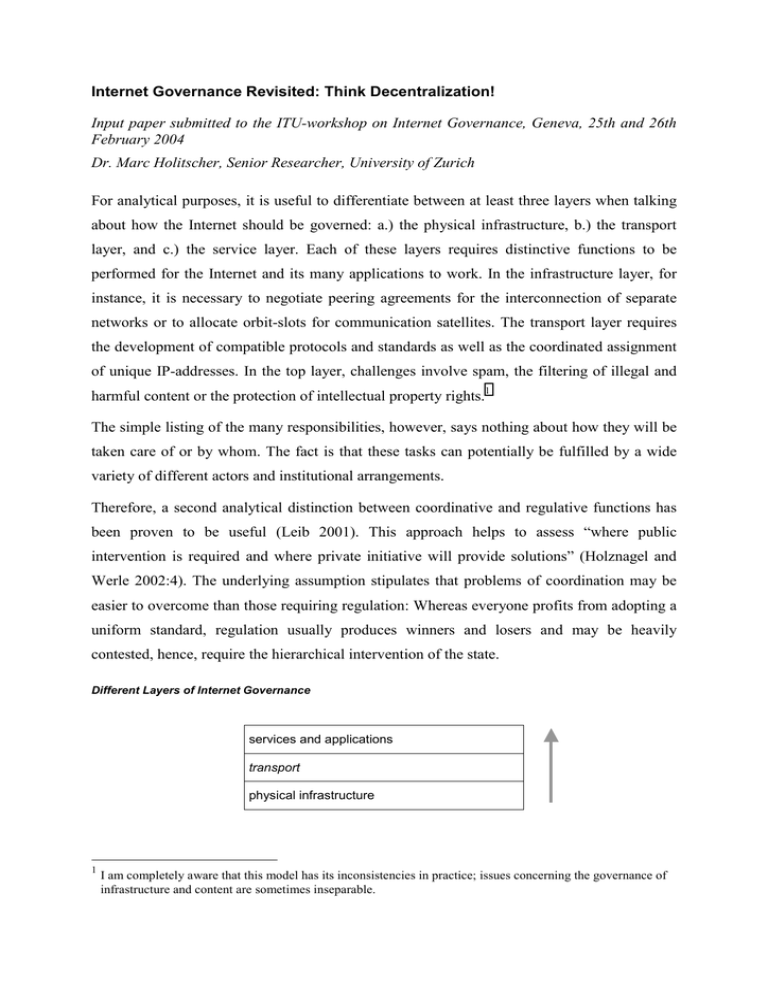
Internet Governance Revisited: Think Decentralization! Input paper submitted to the ITU-workshop on Internet Governance, Geneva, 25th and 26th February 2004 Dr. Marc Holitscher, Senior Researcher, University of Zurich For analytical purposes, it is useful to differentiate between at least three layers when talking about how the Internet should be governed: a.) the physical infrastructure, b.) the transport layer, and c.) the service layer. Each of these layers requires distinctive functions to be performed for the Internet and its many applications to work. In the infrastructure layer, for instance, it is necessary to negotiate peering agreements for the interconnection of separate networks or to allocate orbit-slots for communication satellites. The transport layer requires the development of compatible protocols and standards as well as the coordinated assignment of unique IP-addresses. In the top layer, challenges involve spam, the filtering of illegal and harmful content or the protection of intellectual property rights.1 The simple listing of the many responsibilities, however, says nothing about how they will be taken care of or by whom. The fact is that these tasks can potentially be fulfilled by a wide variety of different actors and institutional arrangements. Therefore, a second analytical distinction between coordinative and regulative functions has been proven to be useful (Leib 2001). This approach helps to assess “where public intervention is required and where private initiative will provide solutions” (Holznagel and Werle 2002:4). The underlying assumption stipulates that problems of coordination may be easier to overcome than those requiring regulation: Whereas everyone profits from adopting a uniform standard, regulation usually produces winners and losers and may be heavily contested, hence, require the hierarchical intervention of the state. Different Layers of Internet Governance services and applications transport physical infrastructure 1 I am completely aware that this model has its inconsistencies in practice; issues concerning the governance of infrastructure and content are sometimes inseparable. 2 The concept of Internet Governance, as it is broadly defined here, covers the totality of implicit or explicit rules, norms and decision-making procedures – plus the corresponding mechanisms for monitoring, sanctioning and enforcement – that aim at attaining specific patterns of collective behavior on each of the functional layers outlined above. Because of the decentralized architecture of the Internet and its inherent end-to-end principle, most of the aforementioned challenges do not require centralized or even global decisionmaking procedures. In fact, since the reach of network expands far beyond any jurisdiction, it is well possible that the regulation of the same issue varies across countries and regions: Depending on nationality, religion or culture, the safeguarding of minors or the freedom of speech can contrast considerably both in scope and stringency. The disagreement about the protection of personal data between the United States and the European Union is just another case in point. Finally, there also exist many different accounting systems for the interconnection of networks or the leasing of fiber optics. As a result, Internet Governance presently consists of a heterogeneous patchwork of many different national and international rules, directives and interface solutions, as well as only a few harmonized legislations at the global level. However, this it not necessarily a bad thing. From this point of view, universal rules and procedures are only required with regard to such functions that are indispensable for the smooth interconnectivity and interoperability of the many computers and subnets that collectively make up the Internet. These so-called “global areas of administration” (Hofmann 2000) are located in the middle layer of the model outlined above. Generally, these functions entail: a. the coordination and administration of the Domain Name System b. the administration of IP-addresses c. the administration of the A-root d. the development of protocols and standards The fact that some of these functions need a certain degree of centralized management does not mean that they have to be fulfilled or overseen by a central organization. Especially not if subordinate entities or levels of decision making exist that are in command of better knowledge and familiarity with the issue at hand. In fact, the distributed architecture of the Internet opens the road to a unique division of labor along functional confines in a global setting. 3 At present, however, the Internet Corporation of Assigned Names and Numbers (ICANN) – a private international organization incorporated under California law – is ultimately responsible for these functions. Whereas some of these functions are more or less simple coordination tasks (e.g., the allocation of IP-addresses), others entail the distribution of wealth to selected marketparticipants (e.g., through the introduction of new gTLDs). Hence in some areas, ICANN actively engages in the making of global public policy and thus requires some form of public oversight (Holitscher 2004; Leib 2003). Otherwise, those actors who are set to lose by ICANN’s decisions will continue to challenge its procedures and legitimacy as it has happened since the organization’s creation back in 1998 (Mueller 2002). On the other hand, most of the coordinative functions that ICANN currently oversees at the global level could be well handled at subordinate levels of decision-making and do not require centralized management. Hence, the successful installation of a public-private partnership (PPP) would open the road to a creative institutional arrangement that relies on the principle of subsidiarity and public oversight at the same time. After years of criticisms about its lack of legitimacy, ICANN reformed its structure and adopted the model of a PPP back in 2002. The declared aim was that ICANN will primarily focus on technical matters in the future and leave public policy issues to be decided in the appropriate forums, e.g., the supporting organizations. Since ICANN embodies the focal institution of the current discussions about Internet Governance, it makes sense to examine the organization against the background of the PPPconcept. This is even more useful as the PPP-model seems to be generally accepted as the most promising mode of governance for the Internet to come. Additionally, such a comparison will expose some present structural and operational deficiencies that might be avoided in the future. Since ICANN also represents the most important policy precedent in the area of Internet Governance, the specific mix between private and public participation in the organization’s institutional design will certainly serve as a reference for other issue-areas. The conclusion will be that ICANN does not fulfill the requirements of a functioning PPP. There reasons for this are twofold: 1.) on a structural level, ICANN is still unilaterally dominated by the US-government; 2.) on an operational level, ICANN actively engages in the centralization of responsibilities in its own hands. Combined, these shortcomings preclude the emergence of any sustainable institutional arrangement. 4 To begin with, it makes sense to take a closer look at the characteristics and advantages of a public-private partnership compared to the alleged insufficiencies of traditional governmental or intergovernmental institutions. First of all, PPPs gather all parties concerned with a global issue in a non-hierarchical setting. Typically, representatives from governments, industry, and civil society participate in an open dialogue, assisted by intergovernmental organizations. Arguments supporting the delegation of decision-making authority to a PPP usually stress the following incentives (Reinicke 1998): Private actors are often in command of better knowledge and familiarity with the issues concerned. This, in turn, grants PPPs a great degree of flexibility in adopting to a fast-changing and ever more complex environment. Non-state actors, in addition, have a genuine interest in the political process, as long as they are themselves directly affected by the outcome. Finally, the legitimacy of PPPs in large part depends on the quality of the outcomes they produce, i.e., if they do their job well or not (Woods 2002). Thus, the general focus often lies more on the efficiency and problem-solving capacity of a private-public institution than on representation and democratic inputs. The downside of this output-oriented perspective is that it often overlooks conflicts between the actors involved; potential frictions between the members of a PPP might easily be ignored – be they political, ideological or economic in nature (Mayntz 2000). Besides, powerful states can systematically instrumentalize self-regulatory arrangements for the achievement of their own, egotistical ends. It can be argued, for example, that the Clinton administration cleverly concealed its interests with regard to the reform of the Domain Name System by making use of the timely and sexy rhetoric of private-sector self-regulation (Holitscher 2004). Back in 1998, the primary aim was not to achieve a possibly efficient and self-sustained institution for the governance of the Internet, but to keep the Internet out from multilateral forums in the guise of the ITU. In such forums, the US could have been easily overruled by the principle of ‘one nation, one vote’. Additionally and probably most importantly, by keeping other governments away from regulating the Internet, the US with its advanced knowledge and industry in the field, would enjoy the best opportunities in the future. The omnipresent optimism in the current debate about self-regulatory initiatives tends to obstruct the view on these strategic dimensions. 5 Finally, it is crucial to keep in mind that private self-regulation will always be a supplement and can never completely replace public governance. A PPP can lessen the burdens of government by assisting with its expertise or by performing certain tasks more efficiently. Hence, the part to be played for the public sector “will be less substantial policy-making but will rather consist of fulfilling ‘meta-governance functions’ in order to safeguard the conditions under which private actors can interact autonomously” (Wolf forthcoming). The privatization of certain governance functions should not be interpreted as a retreat of the state but rather as a redefinition of its functions (Holitscher 1999). This should appease governments who see their autonomy being eroded by the establishment of alternative modes of political decision-making. As a consequence, we may be witnessing the promotion of a horizontal rather than vertical or hierarchical system of global Internet Governance. Going back to ICANN, this critical evaluation of the PPP-concept reveals the following: Contrary to its announcements in the White Paper of 1998, the Department of Commerce still claims a so-called dormant authority over ICANN. Under these circumstances it is wrong to talk about a public-private partnership with regard to ICANN. It would be more correct to say: a public-private partnership in the shadow of the US government. It should be clear from this statement that the retreat of the US government marks the ultimate precondition for a well-functioning public-private partnership. Governments need to act on a level playing field when defining the boundaries within which the international private sector and civil society should be allowed to self-regulate. As soon as there exists an unbalanced shadow of hierarchy under which these important meta-governance functions are to be fulfilled, the legitimacy of the whole system is jeopardized. With hindsight it can be argued that the early retreat of the US government would have made it a lot easier for ICANN to come to terms with the other actors in the field, especially the ccTLDs or RIRs. As we have learned from recent events at WSIS, every step by ICANN is suspiciously evaluated whether it might indeed reflect yet another trick by the US government to control the root. It is important to keep in mind, after all, that the US government doesn’t really gain much by keeping with its sole stewardship in the current system of Internet Governance. Any unwarranted use of its control would risk the breakup of the voluntary practice by the worldwide ISP-community to point their name servers at the A-root. In fact, the mere symbolism of the unilateral US-control over the Internet’s key infrastructure does much to preclude any constructive development in the direction of a better system of governance. 6 In this respect, it is important to point out that the current strategy to establish some regional bureaus in different parts of the world is no way to absorb the need for a true multilateralization of ICANN’s oversight. Closely connected to what has been said is the second deficit of the current system: Since its establishment back in 1998, ICANN lacks the necessary legitimacy so that all actors play by its rules. This reluctance on part of the Internet community, though, has led ICANN to react in two distinct ways: On the one hand, ICANN ever more openly tried to associate itself with governments in the hope that they might convince their respective DNS-managers to join ICANN. On the other hand, ICANN started to behave quite straightforward when its demands were not met. A very instructive example has been the controversy in connection with the bankruptcy of the European ISP KPNQuest in spring 2002. Back then, ICANN openly refused to update the root-zone file with the addresses of some new name servers until the European ccTLDs acceded to certain demands: “This exercise, however, demonstrated to the Internet technical community that ICANN would risk the stability of the Internet – its entire reason for existence form the technical community’s perspective – to achieve its policy objectives” (Feld 2003:352). As a consequence, the private DNS-managers, the ccTLDs, RIRs as well as the operators of the dispersed root-servers, have been very careful about safeguarding their autonomy vis-à-vis ICANN. The last part of this paper delineates a possible way out of the current impasse. It not only sketches the necessary reforms the current ICANN-system must undergo but also the fundamental institutional preconditions any system of Internet Governance has to meet if it is going to be sustainable. ICANN itself will be just a narrow part of this evolving universe. At the top of the envisaged system must be some kind of an intergovernmental agreement that fulfills the aforementioned “meta-governance function”, in the sense that it sketches the scope within which the private sector and civil society are allowed to self-regulate. In keeping with the spirit of a lightweight and flexible PPP, I argue for the establishment of a framework convention that would be open to every interested government. The convention would contain no legislation but only specify which organizations – governmental and non-governmental – would be collaboratively responsible for which aspects of the Internet and what their respective competencies would be. 7 Even in the best of all possible worlds, self-governance has to leave room for political oversight and dispute resolution. The formulation of specific rules and procedures as well as their implementation and enforcement would be completely delegated to designated non-state actors. How these embedded self-regulatory arrangements would look like is open to consideration. There is a wide spectrum of institutional designs, which can possibly ensure transparency, deliberative quality and procedural fairness (Wolf forthcoming). Intergovernmental organizations could act as facilitators and assist the private actors in overcoming problems of collective action. Hence, governmental actors would serve as moderators and enablers of private-self regulation and provide the nongovernmental actors with the necessary authority to make legitimate decisions. In such a system, ICANN would be just one organization among many others. The decisive difference being that its responsibilities and duties would be defined in the constitutional convention and not bi- or tri-annually renewed in a MoU with the Department of Commerce. With respect to ICANN, there is an obvious need for its mission to be further narrowed. This however, should not be intimately connected to the naive hope for de-politicization of the DNS-issue. Rather, ICANN must realize that the exaggerated centralization of decisionmaking power stands in direct opposition to the Internet’s decentralized architecture. To be successful in the future, the company has to engage in a functional division of labor that rests on the principle of subsidiarity. Given adequate checks and balances by the private sector and civil society, ICANN could be well performing the original IANA-functions, further restraining itself to the administration of gTLDs. A trilateral Policy Oversight Committee could ultimately oversee the specific functions that require policy actions – like for instance the management of gTLDs or the administration of the root-zone file. All other tasks and responsibilities could be delegated to existing and well-performing entities: the development of protocols and standards to the IETF, the management of ccTLDs to the country-specific registries and so forth. It would be naïve to think that governments refrain from regulating the Internet if they consider it necessary. Co-Regulation in the multilateral sense sketched above – and not in the minilateral sense currently performed – can defuse the potential for conflict inherent in issues of global public policy. A distributed approach would also be in tune with the architectural design of the 8 Internet itself, which emphasizes principles as delegation and decentralization and not centralization and hierarchy. As long as this does not happen, governments will continue to politicize the issue of Internet Governance in general and ICANN in particular. This would foreclose the establishment of a functioning institutional arrangement for the foreseeable future. Literature Feld, Harold. 2003. "Structured to Fail: ICANN and the "Privatization" Experiment." Pp. 333362 in Who Rules the Net? Internet Governance and Jurisdiction, edited by Adam Thierer and Clyde Crews. Washington, D.C.: Cato-Institute. Hofmann, Jeanette. 2000. "Und wer regiert das Internet? - Regimewechsel im Cyberspace." Pp. 67-78 in Global@home. Jahrbuch Telekommunikation und Gesellschaft 2000, edited by Herbert Kubicek et al. Heidelberg: R. v. Decker. Holitscher, Marc. 1999. "Global Internet Governance and the Rise of the Private Sector." Swiss Political Science Review 5:134-142. Holitscher, Marc. 2004. Die Regulierung des Internets zwischen technischer Koordination und politischer Steuerung: Eine explorative Einzelfallstudie am Beispiel der Internet Corporation for Assigned Names and Numbers zur Rolle privater Akteure in den internationalen Beziehungen. Zürich: Universität Zürich. Holznagel, Bernd, and Raymund Werle. 2002. "Sectors and Strategies of Global Communications Regulation." Zeitschrift für Rechtssoziologie 23:3-22. Leib, Volker. 2001. "Das Doppelgesicht von Icann: Koordination und Regulierung des Internet." Available from: http://www.politikdigital.de/edemocracy/icann/doppel.shtml. Leib, Volker. 2003. ICANN und der Konflikt um die Internet-Ressourcen: Institutionenbildung im Problemfeld Internet Governance zwischen multinationaler Staatstätigkeit und globaler Selbstregulierung. Konstanz: Universität Konstanz. Available from: http://www.ub.uni-konstanz.de/kops/volltexte/2003/970/ Mayntz, Renate. 2000. "Politikwissenschaft in einer entgrenzten Welt." in MPIfG Discussion Paper. Köln. Mueller, Milton. 2002. Ruling the Root: Internet Governance and the Taming of Cyberspace. Cambridge, MA: MIT Press. Reinicke, Wolfgang H. 1998. Global Public Policy: Governing without Government? Washington, D.C.: Brookings Institution Press. Wolf, Klaus Dieter. Forthcoming. "Some Normative Considerations on the Potential Limits of Voluntary Self-Regulation." in Transnational Self-Regulation and its Discontents, edited by Christian Brütsch, Dirk Lehmkuhl, and Dieter Ruloff. Woods, Ngaire. 2002. "Global Governance and the Role of Institutions." Pp. 25-46 in Governing Globalization: Power, Authority and Global Governance, edited by David Held and Anthony McGrew. Cambridge: Polity Press.
